In this written debate, the authors address the title question with essay-length opening statements. The statements are followed by an interactive series of exchanges between authors on each other’s arguments. The goal of this product is not to reach any conclusion on the question, but to offer a rigorous examination of the choices and trade-offs that confront the United States in its competition with China.
As China ramps up its military capabilities and tensions escalate in the Taiwan Strait, there are growing concerns about the risk of conflict that could involve the United States. Given the stakes, it is critical for American leaders and the American public to have a clear understanding of their top interests and objectives in the Taiwan Strait. Is America’s current approach working to protect its top interests? Should the United States change its long-standing policy of “strategic ambiguity” and its “One China” policy? Is conflict avoidable or inescapable? What policy tools will be most effective at upholding peace and stability in the Taiwan Strait?
To dive into these issues and to provide a menu of options for U.S. policymakers grappling with this topic, Ryan Hass, Patricia M. Kim, and Emilie Kimball, co-leads of the Brookings Foreign Policy project: “Global China: Assessing China’s Growing Role in the World,” convened a group of leading experts—Rorry Daniels, Thomas Hanson, Ivan Kanapathy, and Michael E. O’Hanlon—to engage in a written debate examining if the United States should change its policies toward Taiwan. These experts also will participate in a live discussion on this topic moderated by John Rash on April 25. Their opening statements and reactions follow below:
Michael E. O'Hanlon
Should the United States end its long-standing policy of “strategic ambiguity” about whether it would defend Taiwan in the event of a Chinese attack? Known more politely as a policy of “dual deterrence,” the idea of maintaining uncertainty about any American role in a future war has been intended to persuade both Taiwan and China not to take actions that the United States would find unacceptable. For Taiwan, that would mean unilateral pursuit or a declaration of independence (or perhaps the development of a nuclear bomb); for China, that would mean a military attack on Taiwan designed to force reunification with the mainland.
Such deliberate muddying of the deterrence waters has generally been thought to be a bad idea in modern American foreign policy—with an unredeemed legacy from Korea to Kuwait and beyond. For Taiwan, however, such a policy has enjoyed support for four decades.
A number of American scholars and officials now want to end the ambiguity, which they say is bad for deterrence. Given China’s greatly increased power in modern times, the traditional logic of a policy that sought in Goldilocks-style to perfectly balance between hot and cold options is no longer compelling, these critics say. The danger of an emboldened China lashing out has become substantially greater than the risks of Taiwan leaders throwing caution to the wind and pursuing independence recklessly in the false belief that America will always grant them a get-out-of-jail-free card.
At one level, these critics make a valid case. Beijing cannot be allowed to develop the misimpression that the United States might truly do nothing if the People’s Liberation Army (PLA) attacked Taiwan.
However, it is not that simple. Asserting that the United States should defend Taiwan under any circumstances presupposes that we could do so successfully. It also risks causing a huge crisis just by the simple declaration of Washington’s new stance on the situation.
As authors like Christian Brose have argued, in his recent book, “The Kill Chain,” it is far from clear who would win a fight over Taiwan—and far from clear how escalation would be avoided once the shooting starts. As Ryan Hass points out, this uncertainty is a powerful argument against China undertaking aggression; Beijing cannot be sure it would win, and it can be quite sure there would be serious costs associated with even making the effort. In particular, amphibious assault in the modern era remains a daunting military task. But that said, the United States should not assume that it will be able to regain unambiguous military dominance in regions near China’s own shores just because it develops a National Defense Strategy with that goal.
Indeed, China would likely begin any aggression against Taiwan at much lower levels of warfare, including deniable operations and other “gray-zone” tactics. Because limited attacks, such as a blockade, or gray-zone operations, such as deniable cyberattacks against Taiwan’s infrastructure, are the most likely kinds of aggressions that China would undertake against Taiwan, the United States and allies need better and more proportionate tools to address such eventualities.
I propose that the United States make it unambiguously clear to Beijing that, were it ever to attack Taiwan in a concerted attempt to coerce capitulation and reunification, the U.S.-China relationship could never be the same. War might happen, but we should remain ambiguous and non-committal on that point, partly to deter Taiwan from rash action (according to the original logic of dual deterrence, some of which still applies today). However, Beijing should have no illusions that the rich, broad, mutually beneficial relationship that it built with the United States over several decades could survive such a scenario. For all the setbacks to that relationship during the last decade, and especially since the Donald Trump years, U.S.-China trade remains near record levels in value. China’s trade with key American allies remains robust as well. That is a far cry from what would happen if the two nations wound up in direct combat. If and when such war occurs, the new U.S. policy of “de-risking” should indeed become, and would become, one of decoupling. Washington should say so and also announce that it would seek to persuade its allies and close partners to adopt a similar approach.
Raw military power still has a role to play in undergirding deterrence. But whatever the utility of such a capability against a massive invasion attempt, it is less germane against the much more likely scenario of limited aggression, to include a blockade of some type. In situations where China had not necessarily caused large numbers of casualties itself, the practicality or wisdom of a U.S. response that could quickly kill tens of thousands is not obvious. The essence of a better and more credible strategy should therefore be integrated, and asymmetric, deterrence. Secretary of Defense Lloyd Austin has been rightly emphasizing the integrated element, just as I did in my 2019 book, “The Senkaku Paradox: Risking Great-Power War over Small Stakes.”
For this strategy to deter successfully, advance preparations are required. That is especially true in the realms of economic resilience, perhaps even more so than in more technical matters of defense planning. As rough rules of thumb, American friends and allies should not allow themselves to develop dependencies of more than a given percent—perhaps typically 25 to 50 percent, depending on the area of trade and the possibility of finding alternative sourcing fast in a crisis—in everything from life-saving pharmaceutical medications to rare earth metals to key intermediate goods in supply chains for crucial technology such as transformers. Right now, of course, the Western world’s combined dependencies often are more than 25 to 50 percent, so we need to diversify and harden our economies. In other words, we must imagine ourselves in an economic war with China and be sure that our economies and peoples could survive that war (even if they face inevitable hardship in the process). If the threat of economic pain and punishment is to be a cornerstone of our deterrent against limited attacks in particular, the ability of the United States and allies to persevere in the face of inevitable Chinese retaliation in kind must be ensured.
Ivan Kanapathy
The U.S. “One China” policy framework has remained consistent for four decades while retaining flexibility in emphasis and execution to preserve the status quo across the Taiwan Strait. Since the turn of the millennium, however, the scales have tipped dangerously out of balance. To maintain peace, Washington must invest more in hard deterrence. It should also reconsider its messaging posture on “non-support” for Taiwanese independence and how it refers to the collection of relevant U.S. policies.
The first Bush and Clinton administrations began the practices of sending U.S. cabinet members to Taiwan and allowing Taiwanese presidential transit stops in the United States, respectively. But in his second term, President Bill Clinton succumbed to People’s Republic of China (PRC) pressure and publicly articulated U.S. non-support for Taiwanese independence. The George W. Bush administration repeated this line as it worked to constrain the more provocative instincts of a fledgling democracy in Taipei.
Courting PRC cooperation on trade and counterterrorism, the second Bush administration also withheld cabinet-level visits and weapons from Taiwan even as the PLA rapidly modernized. President Barack Obama, pursuing multilateral climate and nonproliferation accords with Beijing, largely continued these policies of keeping Taiwan at arm’s length—despite a deteriorating military balance and a government in Taipei that willingly expanded political and economic ties with China.
Acknowledging the worrying cross-Strait power differential, the Trump administration removed self-imposed barriers to U.S.-Taiwan coordination and accelerated arms transfer approvals. To hammer home the point, the National Security Council declassified President Ronald Reagan’s 1982 internal memo ordering that “Taiwan’s defense capability relative to that of the PRC will be maintained,” and the related six private assurances made to Taipei at that time. President Donald Trump changed the formal articulation of the U.S. “One China” policy framework by adding the six assurances and leading with the Taiwan Relations Act, which obliges the provision of weapons to Taiwan.
To help balance the rising threat, President Joe Biden not only adopted the new formulation but also stated his intent to defend Taiwan against PRC attack, overturning decades of intentional ambiguity on U.S. intervention. Building on a July 2020 U.S.-Australia joint ministerial statement declaring “that any resolution of cross-Strait differences should be peaceful and according to the will of the people on both sides,” the Biden administration broadened and elevated allied statements calling for peace and stability in the Taiwan Strait—enhancing deterrence by internationalizing concern over the Taiwan issue.
The above recitation shows that Washington has historically adjusted the emphases and implementations of its cross-Strait policies. But until recently, preserving a stable military balance across the Taiwan Strait was subordinated to other national priorities and challenges—leading to a dangerous erosion of deterrence. Meanwhile, the United States now finds itself dealing simultaneously with competing hot wars in Europe and the Middle East, unprecedented drawdowns of U.S. arms and ammunition, and a withered defense industrial base. The time to act is now.
- Most importantly, the United States must adequately resource its national security strategy—closing the “say-do gap” by significantly raising defense spending. The country will have to make tough choices and sacrifices in the name of peace and prosperity. The president should use his bully pulpit and make the case to Congress and the American people that China is a threat to global stability and that Taiwan is a vital U.S. interest—invoking the great power contests of the last century.
- U.S. officials should not gratuitously articulate non-support for Taiwanese independence. This statement should only be used when Taipei takes provocative actions—exceedingly rare since 2008. Officials could instead use the neutral formulation of opposing unilateral changes to the status quo. Consider the likely effects of the former statement on three audiences: China, Taiwan, and allies and partners.
China. Attempts to reassure China regarding U.S. intentions are misguided and fruitless. From Beijing’s view, U.S. weapons and training cannot but support Taiwan’s continued separation. Furthermore, Washington openly opposes the governance methods deployed in Tibet, Xinjiang, and Hong Kong—presumptive models for a “unified” Taiwan. In the minds of PRC leaders, the United States remains the duplicitous “black hand” stirring anti-China dissent and the “strong enemy” the PLA must prepare to defeat. By its nature, the PRC government cannot meaningfully separate U.S. support for Taiwan’s democracy from perceived U.S. support for Taiwanese independence.
Taiwan. The effects in Taiwan are likely counterproductive. Stating non-support for independence signals to Taiwanese that Washington has made a deal with Beijing that presupposes a resolution for cross-Strait differences. The statement inadvertently supports PRC-promoted “U.S. skepticism” narratives in Taiwan that question American intent and reliability. These in turn weaken U.S. efforts to bolster deterrence on the island. A senior U.S. representative’s January public remarks delivered in Taiwan to this effect were thus likely detrimental to U.S. security objectives.
Allies and partners. Instead of congratulating Taiwan for its free and fair January elections, the U.S. president publicly stated his non-support for Taiwanese independence—for the first time since the Bush administration. This statement sent inaccurate and unhelpful signals to third countries, fueling China’s pervasive narrative that Taipei is the destabilizer even as Beijing refuses cross-Strait dialogue and expands military and information operations to undermine Taiwan’s government and divide its people. Unwarranted reproaches detract from U.S. efforts to internationalize concerns over the true threat to cross-Strait peace today: PRC aggression.
- The United States should begin referring to its “One China” policy as its “cross-Strait” policy instead. PRC information operations intentionally conflate the PRC’s “One China principle” with the subtler cross-Strait policies of other countries, claiming that “more than 180 countries and international organizations have reaffirmed their commitment to the one-China principle.” This proposed U.S. nomenclature change would make it easier to push back on the PRC’s misattributions and help unwind its narratives that isolate Taiwan from the international community, again potentially enhancing deterrence.
Rorry Daniels
The United States has never had a static Taiwan policy but always ebbed and flowed with shifting dynamics between Washington, Beijing, and Taipei. After switching recognition from Taipei to Beijing in the late 1970s, U.S. policy toward Taiwan has been shaped by U.S.-China communiques, congressional acts, and executive branch statements and codified by “transit” visits of key Taiwan leaders to the United States, a growing list of arms sales, and even sending the U.S. Navy’s 7th Fleet toward the Taiwan Strait during the 1990’s missile crisis. Taiwan policy is best seen as an ongoing process underpinned by the United States’ de facto neutrality—namely, the United States takes no position on the sovereignty of Taiwan but wants to see the issue resolved without the use of force or coercion.
This political ambiguity has allowed a stable status quo in the Taiwan Strait—one of no unification, no independence, and no use of force—and enabled Taiwan to exercise considerable autonomy from Beijing despite Taipei having very few formal diplomatic allies. It has been one of the most successfully durable and flexible U.S. foreign policies in the modern era and it is still the best hope to forestall global catastrophe arising from a conflict over Taiwan.
U.S. de facto neutrality on the settlement of Taiwan’s sovereignty has accomplished two things: first, it leaves open the door for the sovereignty issue to be resolved in either side’s favor, therefore allowing all capitals to kick the can down the road until circumstances most favor their preferred resolution; second and relatedly, it keeps Taiwan’s status in the realm of a political, rather than a military, dispute.
It remains in the U.S. interest to support Taiwan’s thriving democratic system and its political autonomy from Beijing—as well as to forestall or reduce the risk of conflict in and around Taiwan. This is a difficult balance to achieve. Too much unilateral support for Taiwan increases the risk of conflict, and too little erodes Taiwan’s ability to exercise autonomy.
This balance is becoming increasingly difficult to maintain as the Chinese Communist Party modernizes its military and continuously emphasizes the imperative to resolve the Taiwan issue by mid-century. The question for the United States becomes, how can it remain neutral on the overall question of Taiwan’s sovereignty while still pushing back against the PRC’s use of coercion and implied threat of force against Taiwan?
The more Washington leans into a preference for Taiwan independence, the more the threat of force against Taiwan increases. As the United States erodes its neutrality with policy changes, it hardens views in Beijing that there is no hope for a political settlement and that the PRC must rely on military means to achieve its Taiwan goals.
Such policy changes in recent years have been numerous. A non-exhaustive list includes:
- Language shifts in regular policy statements that replace support for an outcome acceptable to both sides of the Strait with an outcome acceptable to (only) the people of Taiwan.
- The declassification in 2020 of the Six Assurances the United States privately provided to Taiwan in the 1980s, which declared no U.S. commitment to stop arms sales at a specific date after agreeing in the third U.S.-China communique to reduce such sales.
- Sloppy references to Taiwan as a “country” in national security policy documents and State Department fact sheets.
- Deletion and reinsertion of language on the State Department website on not supporting Taiwan’s independence.
- The liberalization of the State Department’s Taiwan guidelines governing how officials engage in the unofficial relationship, including allowing officials from both sides to meet at government buildings.
- Very high-level political visits to Taipei, such as that of former U.S. Speaker of the House of Representatives Nancy Pelosi, who was third in the presidential line of succession at the time of the trip.
Supporters of the above policy moves tend to put military competition above all other considerations and see the political support as a necessary deterrence strategy. However, recasting Taiwan as a military problem with political dimensions, rather than a political problem with military dimensions, is a major mistake. It undermines all sides’ ability to handle the sovereignty issue, creating a path dependence toward conflict, by devaluing the effects of political maneuvering and changes.
A security dilemma has developed in the Taiwan Strait in which all sides see their own actions as defensive or deterrent in nature and see the other side’s actions as aggressive enough to warrant a response. Beijing builds up its military capabilities in ways it sees as preparatory defense against a Taiwan declaration of independence, Washington interprets the capabilities as intent to attack Taiwan and strengthens its support for Taipei in ways it sees as necessary defense (including the policy changes referenced above), Beijing reacts to those actions with its own “defensive measures,” and the cycle continues.
This cycle moves ever closer to the fundamental red lines on all sides: the PRC’s red line on independence and permanent separation, Taiwan’s red line on coerced or forced unification, and the U.S. red line on the outbreak of conflict. And the closer the three sides get to crossing each other’s red lines, the more likely that a single action sparks an uncontrollable escalation of conflict—one that is not in the national interests or the public appetite of Taiwan, the United States, and presumably even China.
Pushback is necessary but using U.S. force as a blunt instrument to confront the PRC’s military threat or use of coercion does little to support U.S. and Taiwan interests in peace and stability across the Strait. The optimal approach is not to attempt to meet these threats on Taiwan’s behalf through U.S. guarantees of military support or political showmanship but to help Taiwan prosper under threat by materially supporting Taiwan’s economic and social linkages around the world. In other words, the best defense is to diffuse the power of the threat by complicating the stakes of the conflict.
Successfully supporting Taiwan’s prosperity under threat includes using Taiwan’s economic autonomy to strengthen its resilience and to network its industries with partnerships around the world. Taiwan faces unique challenges as an island economy, particularly as one that has eschewed nuclear power in the wake of the Fukushima disaster. Helping Taiwan through international partnerships with its land, water, and power resilience will further embed other economies in the risk of cross-Strait conflict, raise international awareness about the PRC threat to Taiwan, buy the United States time to explore policy options in the event of a blockade, and prove that democracies can work together to manage shared challenges.
The more uncertain the conflict environment, the less confident Beijing will feel in launching a successful attack. The Taiwan issue’s importance for Beijing’s domestic political legitimacy is a double-edged sword. On the one hand, it pushes Beijing toward policy responses, including threats of force or the use of coercion, to bolster and self-justify its position on Taiwan’s sovereignty. But on the other hand, no Chinese leader can risk a failed attempt to settle the sovereignty issue once and for all. Even a more risk-tolerant Xi Jinping is unlikely to shoot for the moon by launching an attack on Taiwan that is not guaranteed to succeed.
In short, the more international attention and support for stability across the Taiwan Strait, due to deepening linkages between today’s Taiwan and the international community, the higher the cost to China for breaking the peace.
This approach may not be satisfying to those who see the Taiwan issue as a mere facet of the U.S.-China great game, or whose exclusive interest is American military advantage. But it does support U.S. interests in regional peace and prosperity, as well as what polls show the majority of Taiwan people want—a durable status quo, officials who can solve economic problems at home, and the continuation of Taiwan’s autonomy and dignity as a self-organized and self-governing body politic.
Thomas Hanson
U.S.-China relations are plagued by mutual distrust and a drift toward potential conflict. In addition to intense competition over new technologies with military implications, the primary driver of tensions involves Taiwan. The security dilemma prevails, with each side reading aggressive intent into the other’s policies and actions. This vicious circle should be met with active diplomacy and a return to predictable adherence to a U.S. policy of “strategic ambiguity” regarding Taiwan. At the same time, it will be important to maintain deterrence in the Taiwan Strait within this context.
Strains between the United States and China grew with the 2008 financial crisis, leading to the Obama administration’s “pivot” (rebalancing) to reassert U.S. influence in Asia with an initial focus on China’s role in the South China Sea. Ironically, as the United States turned to Asia, China began its own pivot toward Eurasia with an ambitious geoeconomic strategy epitomized in the Belt and Road Initiative. So far, the Chinese challenge globally is more economic and diplomatic than military. It is on the Asian littoral around Taiwan that military confrontation looms with the United States.
When nuclear powers perceive, rightly or wrongly, encroachment and potential aggression on their immediate periphery—whether Ukraine, Cuba, or Taiwan—they predictably react. Chinese concern that the United States seeks to use Taiwan as part of a containment strategy is one driver of worsening tensions. On the U.S. side, there is rare bipartisan agreement in Congress on countering unfair Chinese trade practices, human rights violations, and rapid advances in tech, while also stepping up support for Taiwan as a vibrant democracy and vital link in key supply chains.
An underlying motivation for this more assertive posture is also the long-standing U.S. resolve to prevent the emergence of a regional hegemon, or peer competitor, in Eurasia. Realizing this ambition is more complex in a multipolar world of strengthened regional powers, and it increasingly requires buy-in from allies. Such strategic concerns have come to frame U.S. policy on Taiwan more overtly. For example, in a December 2021 Senate testimony, Pentagon official Ely Ratner described Taiwan as “a critical node within the first island chain, anchoring a network of U.S. allies and partners … that is critical to the region’s security and critical to the defense of vital U.S. interests in the Indo-Pacific.”
The evocation of vital security interests implies that for strategic reasons the United States opposes the reunification of Taiwan with China, even as it cautions the Taiwanese against declaring outright independence. Prior adherence to “strategic ambiguity” has given way to mixed messaging on the “One China” policy that has provided the basis of U.S.-China reconciliation since 1972.
Given these developments, there is now a need for change in the current trajectory of U.S. policy on Taiwan. To reverse the rising danger of military confrontation between the United States and China, the United States should once again embrace “strategic ambiguity” while engaging in active diplomacy and military confidence-building measures with Beijing. Such steps will be essential to meet the security dilemma that plagues the U.S.-China relationship.
The military balance around Taiwan should be addressed within this context. The escalation of China’s military buildup, including toward Taiwan, has coincided with the unfolding of the U.S. “pivot” to Asia since 2010. For both sides, military distrust has come to dominate bilateral relations in the region. Xi has urged the Chinese military to be prepared to seize Taiwan, if necessary, as early as 2027, although decisions will depend on future developments. U.S. defense planners must also prepare for more likely scenarios involving Chinese quarantines, blockades, or seizure of islands off Taiwan. In addition, China has embarked upon a diversification of its nuclear arsenal, moving away from a “minimum deterrence” posture toward a credible nuclear second-strike capacity based on launch on warning and new strike options such as the fractional orbital bombardment system.
This dangerous escalation should occasion not just spiraling countermeasures but a return to active diplomacy on arms control. In tandem with diplomatic initiatives and confidence-building measures, the United States should take adequate steps to address shifting military balances that are the premise of this discussion, including through a far greater emphasis on naval preparedness within the U.S. defense budget.
The need for cooperation between the United States and China is growing in the face of shared global threats such as climate change, pandemics, and arguably artificial intelligence that are beyond the capacity of any individual country or fragmentary alliance to address. Younger generations are likely to prioritize these global challenges over Cold War paradigms from an outdated threat environment.
Accumulating crises elsewhere are already having some effect. Chinese cooperation could be welcome on Ukraine and the Middle East, as well as on unaddressed nuclear provocations from North Korea. Accordingly, there has been a slight easing of U.S.-China tensions in the wake of the November 2023 meeting between Presidents Biden and Xi and a phone call between both leaders in April. Mixed results from the January 2024 Taiwan elections may also have a mitigating effect. However, cooperative “gestures” that have resulted from this mild thaw, including the resumption of military-to-military contacts, rest on shaky foundations and should be reinforced through active diplomacy, especially in the management of issues concerning Taiwan.
The U.S. commitment to Taiwan’s security and prosperity remains essential to any prospect of a peaceful resolution, however long it may take, of Taiwan’s future status. A combination of returning to “strategic ambiguity,” proactive confidence-building measures, and credible naval preparedness in the Indo-Pacific region could reduce the likelihood of sleepwalking into a disastrous conflict. Such a balanced approach could also benefit a Taiwanese population for whom the sufferings of Ukraine may now loom as a cautionary tale. And a renewed emphasis on diplomacy might even lessen our geopolitically questionable urge to push Beijing and Moscow together, the very dynamic that motivated our turn toward China in the first place, a half-century ago.
Responses
Michael E. O'Hanlon
The other scholars involved in this dialogue bring great expertise and sophistication to the subject; many are regional and country specialists in ways I am not. Therefore, I will use this podium for wrap-up commentary simply to reiterate, strongly and clearly, one key argument about military matters, which I have studied in great depth: A U.S.-China war must never be fought. The uncertainties about which side would win are not resolvable. That will remain true regardless of any plausible military modernization efforts by either side. The potential for escalation in any war is enormous. The possibility of nuclear war cannot be dismissed. All other considerations must be rendered secondary in comparison with these fundamental military and strategic realities. Those who would push either independence or reunification on any fast track are therefore reckless.
Ivan Kanapathy
As expected, my co-panelists’ well-crafted and thoughtful pieces provide much to consider. I offer these initial reactions as a starting point for our forthcoming in-person discussion:
- O’Hanlon rightly pointed out that “China would likely begin any aggression against Taiwan at much lower levels of warfare, to include deniable operations and other gray-zone tactics.” In fact, we’re already past that point. Analogously, while his proposal for a credible threat of bilateral economic decoupling is sound, I believe that Beijing already assumes this in its planning, just as it predicts U.S. military intervention. Xi is aggressively pursuing technological indigenization and economic self-sufficiency while simultaneously indoctrinating his people to glorify sacrifice and struggle. In other words, China is actively preparing to accept a heavy economic cost (punishment) for aggression. To prevent the worst, Washington should focus on influencing Xi’s perception of military risk (deterrence by denial).
- Hanson’s analysis of congressional sentiment is spot on. On the executive side, he pointed to Ratner’s 2021 testimony. Another senior defense official later said Taiwan “could be used as a platform for the PRC to further project military power deeper into the Pacific.” Coupling these with the administration’s analysis that the PRC is “the only competitor with the intent, will, and capability to reshape the international order” makes Taiwan a vital U.S. interest, even before considering semiconductors (which only make the case stronger). The question, then, is whether Washington should: articulate these fact-based assessments to spur the investments and reforms necessary to compete and deter effectively or return to a posture of “non-provocative” constructive engagement. Accepting further erosion of cross-Strait deterrence in exchange for vague and unkept promises seems the wrong choice at this time.
- Daniels argues for deeper internationalization of the Taiwan issue—I agree. However, we should not underestimate the provocative nature of these proposals. Supporting Taiwan’s “political autonomy from Beijing” and “economic and social linkages around the world,” and raising “international awareness about the PRC threat to Taiwan” are tantamount to supporting Taiwanese separatists in the eyes of Beijing. As such, these prescriptions are hardly a path to lowering U.S.-China tensions. I also agree with Daniels’ assessment that Xi “is unlikely to shoot for the moon by launching an attack on Taiwan that is not guaranteed to succeed,” which is why U.S. policy should focus primarily on the issue recently raised by the top U.S. operational commander: increasing hard deterrence.
Rorry Daniels
All of the authors agree that the current situation in the Taiwan Strait is dangerous and that a war would be catastrophic. All of us agree that a changing balance of power across the Taiwan Strait requires at least a review—if not a rethink—of what has made U.S. Taiwan policy successful and whether it remains fit for purpose. However, we differ on the drivers of risk and prescriptions for maintaining peace and stability.
Each of my fellow authors makes their own case for the best deterrence strategy, from Kanapathy’s recommendations to bolster military support and O’Hanlon’s deterrence threat of economic decoupling to Hanson’s plan to address U.S.-China strategic mistrust. I concentrate in my piece on a wider net of deterrence, complicating the decision-making landscape by making better use of Taiwan’s asymmetric advantage—the freedom to pursue economic and social ties with the world.
None of these strategies are actually mutually exclusive. In theory at least, it would be perfectly fine to simultaneously bolster U.S. capabilities to assist Taiwan’s defense, warn Beijing that the use of force against Taiwan would lead to a sharp decoupling, maintain and deepen diplomatic relationships to reassure that U.S. strategic intent is to avoid war, and to seek opportunities to lend support for Taiwan’s international economic and social ties.
But in reality, no strategic plan can be complete without considering and factoring in Beijing’s reactions. This is where cracks in each plan start to emerge.
O’Hanlon’s and Hanson’s plans are incomplete on their own but could be linked together to inform both sides of the deterrence coin: a threat, albeit non-military, to act if Beijing crosses the U.S. red line, and a reassurance delivered by stronger diplomatic contact. Together, they create the carrots and sticks dynamic of a successful deterrence strategy. Of course, China is already preparing for economic struggle against the United States and such a threat would lend credibility to the hawkish voices in Beijing that China needs to be even more self-sufficient—which would deepen strategic mistrust and the security dilemma. Still, muddling through U.S.-China tension may ultimately be the best and only available course.
Of all of the authors, I find Kanapathy’s plan to be the most ambitious but also the riskiest for maintaining cross-Strait peace and stability. Kanapathy’s strategy is to ratchet up political support for Taiwan in order to energize the American public and defense industry to the cause of defending Taiwan against China. This would undermine any reassurances to Beijing that the United States does not seek war (a common-sense policy that Kanapathy dismisses outright), go against public opinion that is wary of war with China, cause Beijing to rethink the value of any other cooperation with the United States on areas where there remain common interests, and potentially stretch U.S. resources to a breaking point with no guarantee that we are preparing well for war scenario we have not yet seen in the modern era.
All of the authors care deeply about Taiwan and its future. That we can bolster and build our own ideas on the U.S. role in maintaining Taiwan’s autonomy from Beijing through civil debate is an enduring strength of free and democratic societies.
Thomas Hanson
All four contributors see the danger of military conflict over Taiwan, but they differ on which tools of statecraft—diplomatic, economic, or military—should take priority to deter Chinese aggression, reinforce Taiwan’s security and prosperity, and work toward the peaceful resolution of a standoff dating back to 1949. For my part, active diplomacy and military confidence-building measures should become a priority, along with necessary investment to assure a military balance in the Indo-Pacific region, accompanied by political and economic support for a vibrant Taiwan economy.
Daniels and I lament the “security dilemma” of mutual distrust that exacerbates tensions over Taiwan. Kanapathy agrees but feels that attempts to reassure China of our intentions would be “misguided and fruitless.” Daniels would stick to a policy of strategic ambiguity to make sure Taiwan remains a “political problem with military dimensions” rather than vice versa. I emphasize diplomacy and trust building, despite military tensions, in a larger context of global threats that urgently require U.S.-China cooperation.
Daniels and O’Hanlon favor economic tools but in different ways. Daniels maintains that the best way to bolster Taiwan is through support for its democracy, domestic economy, and strengthened ties to the outside world. This could enhance deterrence by complicating the stakes and increasing the cost of aggression. Such a policy might face headwinds, however, given China’s success in peeling away international support for Taiwan in recent years.
O’Hanlon emphasizes economic measures as a key element of “integrated and asymmetric deterrence” that mixes strategic ambiguity with the clear threat of “economic pain and punishment” should China act against Taiwan. He notes that strategic ambiguity serves as a deterrent not only to China but also to Taiwan, reducing the likelihood that Taipei might overreach out of a sense of moral hazard.
O’Hanlon posits that an economic strategy would be most effective against Chinese actions short of military invasion, such as blockades or gray-zone tactics—the most likely scenario. With strong support from allies and close partners, he says, de-risking would become harsh de-coupling. Yet any deterrent effect might lose credibility due to the example of Ukraine, where partners in the Global South such as India have demurred on economic sanctions against Russia.
Kanapathy recommends “hard deterrence” out of justified concern about the military balance around Taiwan. He advocates a comprehensive approach to include increased U.S. defense budgets and clear messaging that Taiwan is a vital U.S. interest. In that regard, he differs from the other three authors by recommending that we drop references to a “One-China” policy and replace it with “cross-Strait” policy in public messaging.
Kanapathy also cites the need to “internationalize” concerns about threats to Taiwan. In fact, the United States has already encouraged countries like Japan to take a stronger stand. In 2021, the late Prime Minister Shinzo Abe and his brother, then-Defense Minister Nobuo Kishi, publicly described Taiwan as a vital Japanese interest, with Abe declaring that “Japan and the United States could not stand by if China attacked Taiwan.” Such statements aligned Japan with U.S. policy but risked evoking ghosts from the past.
One final point: it is perhaps noteworthy that none of the authors mentioned the “porcupine” strategy that would strengthen Taiwan’s homeland defense to allow the island to hold out long enough for the United States to join the fight against China. This scenario differs from Ukraine, where the United States and NATO helped strengthen Kyiv’s defenses after 2014 but with no initial intention of directly going to war with another nuclear power, Russia. Will China’s nuclear buildup eventually induce similar caution in U.S. calculations on Taiwan?
The Brookings Institution is committed to quality, independence, and impact.
We are supported by a diverse array of funders. In line with our values and policies, each Brookings publication represents the sole views of its author(s).







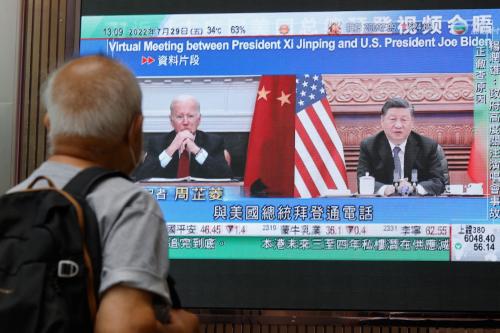
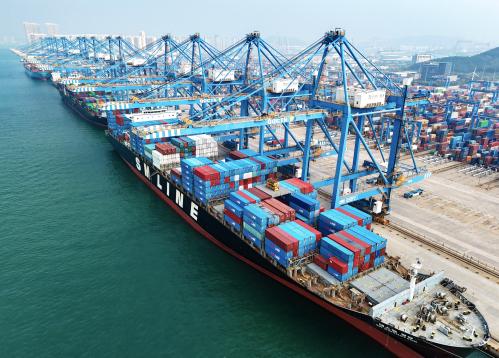

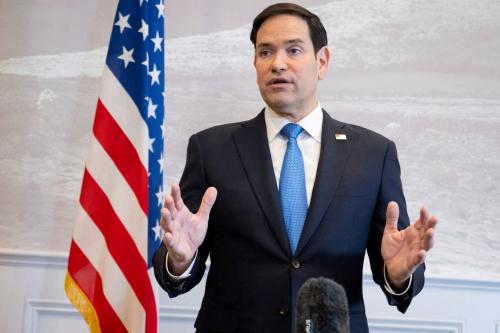
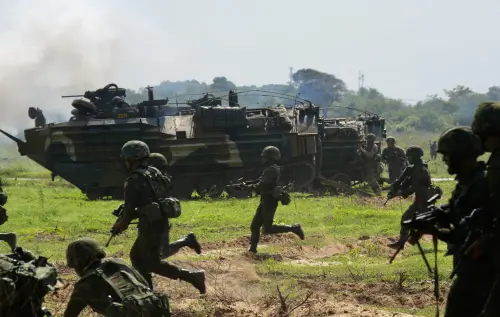
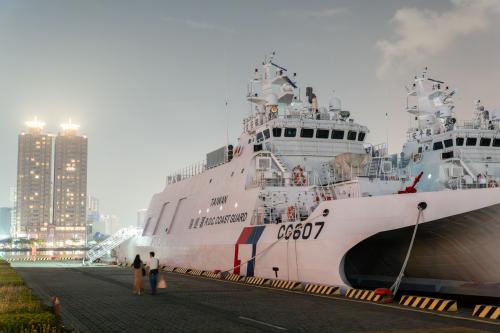
Commentary
Should the United States change its policies toward Taiwan?
April 16, 2024